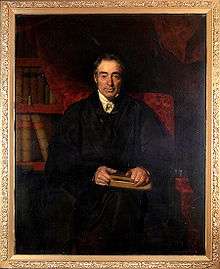Samuel Lee (linguist)

Samuel Lee (14 May 1783 – 16 December 1852) was an English Orientalist, born in Shropshire; professor at Cambridge, first of Arabic and then of Hebrew language; was the author of a Hebrew grammar and lexicon, and a translation of the Book of Job.
Biography
Born of poor parents at Longnor, a Shropshire village 8 miles from Shrewsbury, Samuel Lee received a charity school education and at age twelve became a carpenter's apprentice in Shrewsbury. He was fond of reading and acquired knowledge of a number of languages. An early marriage caused him to reduce the time devoted to his studies, but the accidental loss of his tools caused him to become a school teacher, giving private lessons in Persian and Hindustani.
His remarkable linguistic abilities eventually brought him to the notice of the Church Missionary Society, which paid for his education at Cambridge University. He entered Queens' College, Cambridge, in 1813. He graduated B.A. in 1818, and proceeded M.A. in 1819, B.D. in 1827, and D.D. in 1833.[1]
Building on the work of the Church Missionary Society missionary Thomas Kendall[note 1] and New Zealand chiefs Hongi Hika and Tītore he helped create the first dictionary of te Reo, the Māori language.[2]
In 1819, he became professor of Arabic at Cambridge. At 15 November 1819 foundational meeting of the Cambridge Philosophical Society, the Society committee elected William Farish as president with Sedgwick and Lee as secretaries. In 1823 he became chaplain of Cambridge gaol, in 1825 rector of Bilton-with-Harrogate, Yorkshire, and in 1831 Regius Professor of Hebrew, a position he held until 1848. In 1831 he also became vicar of Banwell, Somerset and remained vicar there until he resigned in June 1838 to become rector of Barley, Hertfordshire, where he died on 16 December 1852.
In 1823 he published a version of the Peshitta which was often reprinted and was the most accessible text for a long time. He claimed to draw upon earlier manuscripts, but Lee did not specify his sources, nor how he had used them, and his text offers very few corrections to that of the Peshitta editions of the Paris and London Polyglots.
He was married twice.[1]
Notes
- ↑ From 1814, missionaries tried to define the sounds of the language. Thomas Kendall published a book in 1815 entitled A korao no New Zealand, which in modern orthography and usage would be He Kōrero nō Aotearoa. Professor Samuel Lee, working with chief Hongi Hika[40] and Hongi's junior relative Waikato at Cambridge University, established a definitive orthography based on Northern usage in 1820. Professor Lee's orthography continues in use
- 1 2 Hamilton 1892.
- ↑ "Maori Studies – nga tari Maori". Te Ara – The Encyclopedia of New Zealand. 22 October 2014. Retrieved 11 July 2018.
- Attribution

References
- Anna Mary Lee, A scholar of a past generation: A brief memoir of Samuel Lee. London (1896)
- Liturgiæ Ecclesiae Anglicanae partes præcipuæ: sc. preces matutinæ et vespertinæ, ordo administrandi cænam Domini, et ordo baptismi publici; in Linguam Persicam traductæ, Portions of the Book of Common Prayer in Persian translated by Samuel Lee (1828), digitized by Richard Mammana


External links
- Works by Samuel Lee at LibriVox (public domain audiobooks)
